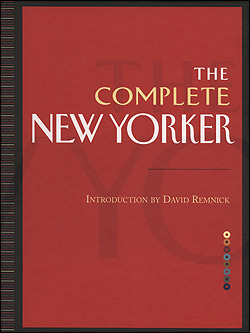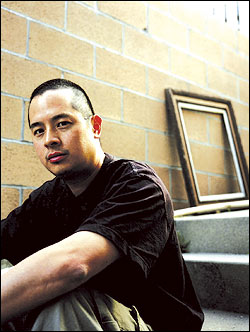Anyone who’s ever taken the plunge of subscribing to The New Yorker has been through the stacking crisis. This is when the magazines, remorselessly arriving week upon week upon week, pile up, unread, looming from the corner of the room, while you promise yourself that, seriously, you will read them all, or at least get started, in one sitting. Not even in Seattle is there a day long and rainy enough to accommodate all that verbiage, though, and usually the stack goes untouched—until something catches your eye in a new issue and you resume your regular weekly reading, wondering why you ever took a break.
Even if you never get through the pile—and unless you make it a project, it’s doubtful that anyone with a life and other entertainment options could—one of the most attractive things about The Complete New Yorker (Random House, $100), the jaw-dropping eight-DVD package featuring scans of every single page of every single issue of the magazine’s 80-year history (through last February), is how enticing it makes the prospect of trying. Not to mention how relatively easy.
For one thing, instead of blowing the dust off endless stacks of back issues, the whole thing can be accessed via a package roughly the width of a month’s worth of physical issues. The DVD search function—on the first disc, which you upload to your hard drive—works for most computers made within the last few years (Windows 2000 and XP, and Mac OS X 10.3 and higher are the preferred operating systems). For another, the search engine, while having the obvious disadvantage of not being able to search the text itself (it’s limited to issue date, subject, author, and the article summaries copied from The New Yorker‘s famous index-card library), is still fairly easy to navigate once you play with it a bit.
It’s hardly a surprise, then, that something designed to fill up as many rainy days as The Complete New Yorker was put together largely in Seattle. This is especially close to home for Seattle Weekly—the technology used on TCNY (and on SW‘s print replica, now available on our Web site, print.seattleweekly.com) was developed by Lizard Tech, whose local headquarters are located just downstairs from our downtown office.
Jeff Foster is a Seattle native whose extensive background in digital imaging included a stint with Getty Images, a major online photo source for various media, when he began working with Lizard Tech a year ago. “The New Yorker project had been in motion for four or five months when I got here,” Foster says in Lizard Tech’s conference room. “They wanted to do the complete series in [the] PDF [format], but PDFs are way too large. Originally, they had planned to issue the series by decade; they were thinking of doing it all over a four-year period. If they’d put it on PDF, it would have been between 30 and 40 DVDs.”
When Lizard Tech’s CEO, Carlos Domingo, got wind of the project, he suggested that the magazine try Déjà Vu, a more compact imaging technology that’s already hugely popular in Asia and throughout Europe, but hasn’t gained quite the same foothold in the U.S. “The technology is perfect for this,” says Foster. “It’s exact copies of the material, and it makes the original sources very lightweight. The original TIFs were 300 times larger than they are [on the finished project]. Once [The New Yorker] learned about the technology, they realized it was the key. We helped them take the files they’d scanned already and encoded them to Déjà Vu.”
Additionally, Foster was able to create a uniform look for the DVDs’ contents. “A scan is like a great photocopy,” he says. “Some of the back-issue copies [of the magazine] were very yellowed; the pages were not in great shape. We helped with proper encoding and recoloring of the pages.” He compares the process to setting the EQ meters on a stereo: “It’s like music—you change the setting to get the best output. The pages now look the same as later issues.”
Despite all the technological derring-do, The Complete New Yorker sells for a relative pittance, making it probably the retail bargain of the coming holiday season. (It was published late last month.) “We had nothing to do with the price,” Foster says. “That was entirely up to them—and a smart decision, I think.” Will other magazines’ archives undergo the Lizard Tech treatment? Foster is keeping mum about that. “We are in talks, but we’re not allowed to say who yet,” he says.









